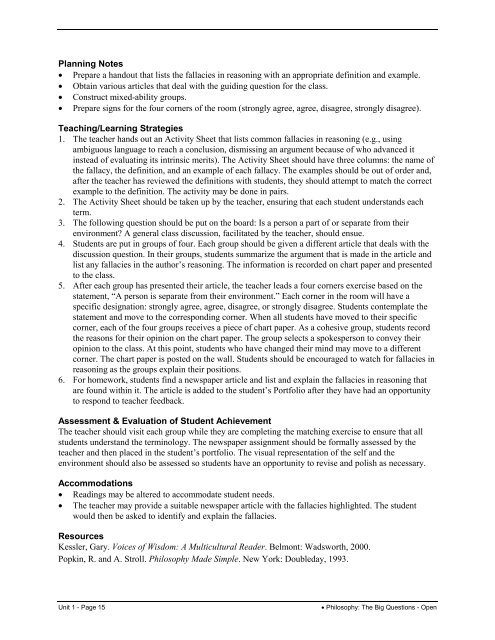Course Profile - Curriculum Services Canada
Course Profile - Curriculum Services Canada
Course Profile - Curriculum Services Canada
You also want an ePaper? Increase the reach of your titles
YUMPU automatically turns print PDFs into web optimized ePapers that Google loves.
Planning Notes<br />
• Prepare a handout that lists the fallacies in reasoning with an appropriate definition and example.<br />
• Obtain various articles that deal with the guiding question for the class.<br />
• Construct mixed-ability groups.<br />
• Prepare signs for the four corners of the room (strongly agree, agree, disagree, strongly disagree).<br />
Teaching/Learning Strategies<br />
1. The teacher hands out an Activity Sheet that lists common fallacies in reasoning (e.g., using<br />
ambiguous language to reach a conclusion, dismissing an argument because of who advanced it<br />
instead of evaluating its intrinsic merits). The Activity Sheet should have three columns: the name of<br />
the fallacy, the definition, and an example of each fallacy. The examples should be out of order and,<br />
after the teacher has reviewed the definitions with students, they should attempt to match the correct<br />
example to the definition. The activity may be done in pairs.<br />
2. The Activity Sheet should be taken up by the teacher, ensuring that each student understands each<br />
term.<br />
3. The following question should be put on the board: Is a person a part of or separate from their<br />
environment? A general class discussion, facilitated by the teacher, should ensue.<br />
4. Students are put in groups of four. Each group should be given a different article that deals with the<br />
discussion question. In their groups, students summarize the argument that is made in the article and<br />
list any fallacies in the author’s reasoning. The information is recorded on chart paper and presented<br />
to the class.<br />
5. After each group has presented their article, the teacher leads a four corners exercise based on the<br />
statement, “A person is separate from their environment.” Each corner in the room will have a<br />
specific designation: strongly agree, agree, disagree, or strongly disagree. Students contemplate the<br />
statement and move to the corresponding corner. When all students have moved to their specific<br />
corner, each of the four groups receives a piece of chart paper. As a cohesive group, students record<br />
the reasons for their opinion on the chart paper. The group selects a spokesperson to convey their<br />
opinion to the class. At this point, students who have changed their mind may move to a different<br />
corner. The chart paper is posted on the wall. Students should be encouraged to watch for fallacies in<br />
reasoning as the groups explain their positions.<br />
6. For homework, students find a newspaper article and list and explain the fallacies in reasoning that<br />
are found within it. The article is added to the student’s Portfolio after they have had an opportunity<br />
to respond to teacher feedback.<br />
Assessment & Evaluation of Student Achievement<br />
The teacher should visit each group while they are completing the matching exercise to ensure that all<br />
students understand the terminology. The newspaper assignment should be formally assessed by the<br />
teacher and then placed in the student’s portfolio. The visual representation of the self and the<br />
environment should also be assessed so students have an opportunity to revise and polish as necessary.<br />
Accommodations<br />
• Readings may be altered to accommodate student needs.<br />
• The teacher may provide a suitable newspaper article with the fallacies highlighted. The student<br />
would then be asked to identify and explain the fallacies.<br />
Resources<br />
Kessler, Gary. Voices of Wisdom: A Multicultural Reader. Belmont: Wadsworth, 2000.<br />
Popkin, R. and A. Stroll. Philosophy Made Simple. New York: Doubleday, 1993.<br />
Unit 1 - Page 15<br />
• Philosophy: The Big Questions - Open
















